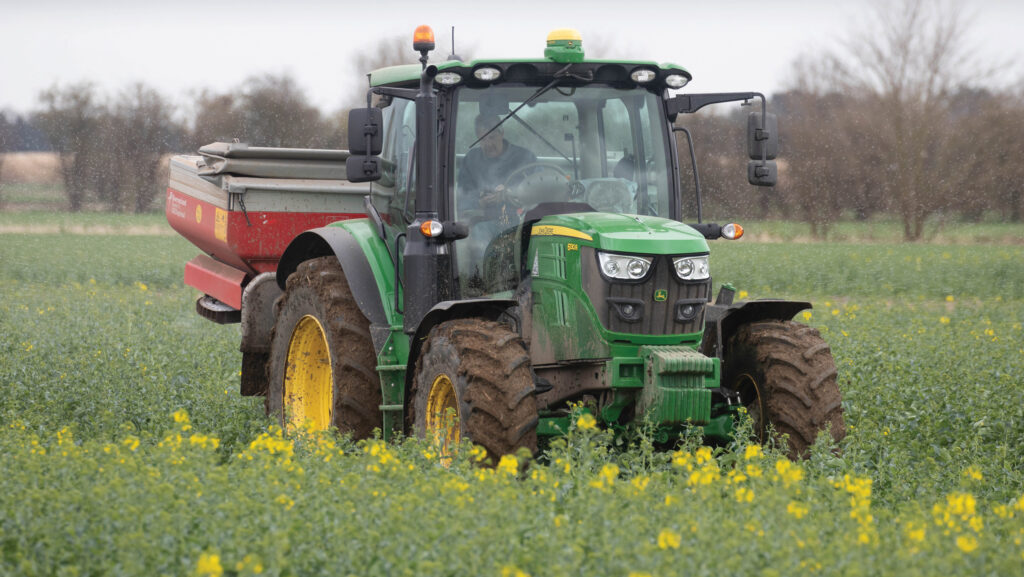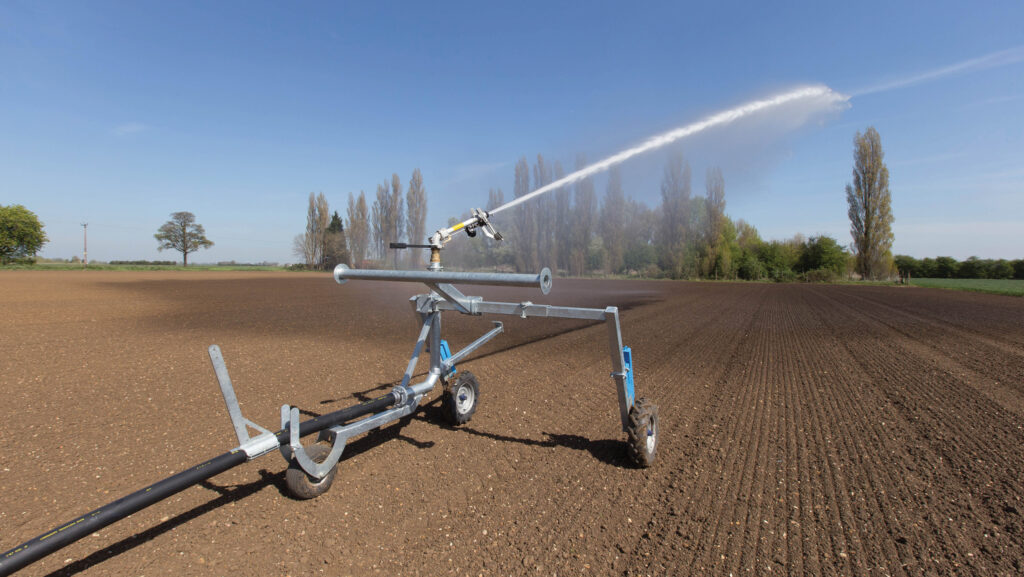Crop Watch: Too dry for some spring crops and OSR starts flowering
 © Tim Scrivener
© Tim Scrivener The continuing dry conditions after one of the driest Marches is seeing good progress on spring crop drilling, but newly establishing crops are needing some rain in some areas of the South and East. There are also concerns that the dry conditions will impair pre-emergence herbicides in combining peas.
See also: Why organic farmer cut back sheep to improve wheat yields
West
Jamie Armstrong, AICC/Wessex Agronomy (Wiltshire, Gloucestershire and Hampshire)
Dry conditions have been the defining feature of the past few weeks and for probably the first time in two years we’ve gone an entire fortnight without rain. Many are reporting the best seed-beds for spring drilling since pre-Covid seasons.
Barley and oat crops have gone into fine, firm tilths, and early-drilled fields are off to a promising start.
Most spring barleys are now at the one true leaf stage or further, with spring oats not far behind. Spring beans drilled in early March are showing two pairs of true leaves and are establishing well.
Oilseed rape crops have taken a few hits from pigeon grazing, but the damage is mostly isolated to a few fields per farm – some more severe than others.
Where plants got away early and kept their vigour, they’ve largely grown through the damage and look well.
Crops have received a prothioconazole-based fungicide for light leaf spot and foliar boron where applicable.
OSR will receive its final nitrogen dose within the next 10 days, particularly where solid nitrogen applications are made before crop height affects the spread pattern.
Winter barley crops are at varying stages. A number of T1 fungicides are being planned this week, though depending on location, some crops are only just starting stem extension.
Brown rust was easy to find in some hybrid varieties at the start of March, but seems to have subsided.
Net blotch has become more prolific as we’ve moved into April. Final nitrogen doses on winter barley should be completed by mid-April.
Tip of the week
Some soils are holding back on nitrogen where rainfall hasn’t yet washed it in. Keeping an eye on crop colour and tiller numbers will help guide any top-up decisions.
Jamie Armstrong
T0 fungicides
Wheat has been slow to get going in the cool, dry conditions, but is now generally at growth stage 30. T0 fungicides are going on where varieties are known to be susceptible to rusts – particularly yellow rust.
There’s little disease about just now, but yellow rust has been seen locally in the South West in varieties such as Extase and Graham. The dry weather can give a false sense of security, so we’re taking a risk-based approach.
With the Easter break looming, I’m already planning T1s on crops I expect to reach timing around or just after Easter, to avoid a late scramble. Crops are clean, but with many only just waking up, nutrition and early spray timings will be important to support tiller retention.
The dry spell has helped travel, but soils are starting to feel tight in places, and some are holding back on nitrogen where rainfall hasn’t yet washed it in. Keeping an eye on crop colour and tiller numbers will help guide any top-up decisions.
Overall, spring work is ticking along well. With field access holding up and crops generally clean and healthy, attention now turns to keeping on top of spray timings and feeding crops through what could still turn into a dry spring.
East
Dan Ives, Agrovista (Herts, Beds, Cambs and Essex)
We have seen plenty of progress during March, with growers making the best of the kind conditions.
Spring cereals, pulses and a good area of sugar beet have been drilled and herbicide applications and second nitrogen dressings to winter cereals have been completed.
However, attention now turns to (dare I say it) much-needed rain across the region. While crops are not yet showing symptoms of stress, a few small showers would most definitely be welcomed.
That said, when digging down moisture is still to be found; where seed-beds were managed well and timely seed-bed nitrogen was applied, spring crops are establishing rather impressively.
Winter wheat is approaching or reaching growth stage 30. Some varieties are getting there much sooner than others, so there is plenty of variable growth.
The most forward crops have had, or are in the process of receiving, T0 fungicides where needed, with later drilled/ slower developed varieties to follow.
This is also a good time to apply micronutrients to crops that may need a little assistance. Tailoring this with tissue tests is also a handy tool.
Yellow rust
I could find my first sign of yellow rust this week in later-sown Skyfall. This variety is an easy target, but it is a good indicator of varietal pressure.
However, we also need to keep an eye out for brown rust, particularly considering 2024 was a high-pressure year for the disease and inoculum can still survive depending on rotation. Winter barleys are receiving their T1 fungicides.
Early flowering sprays on oilseed rape are also beginning. As well as controlling disease, OSR fungicides also provide some canopy manipulation to assist branching, which can be especially useful in backward or pest-damaged crops that are slightly behind on flowering times than normal.
As mentioned, sugar beet drilling has been going well. Weed pressure is generally relatively low.
Some crops have received a post-emergence herbicide but, with frosts still occurring, this can be stressful on young crops.
Monitoring dose rates and timing is key, while mixing with an amino acid product such as Terra-Sorb Foliar Extra can help alleviate stress and improve micronutrient uptake.
North
Conor Campbell, Hutchinsons (Northumberland)
We’ve had a great spell of weather this past month, and work on farm has progressed very well. Spring crops have been going in the ground at pace and the earlier sown cereals are beginning to emerge.
We’ve had the odd frost, but night-time temperatures appear to be on the rise, so hopefully, that is the last of the cold nights.
Temperatures through the day have been cool with plenty of sunshine – exactly what crops are looking for.
Wheat crops on the whole look well, with the majority of T0s on farm ready to be applied this week.
We have been battling yellow rust on the vast majority due to a combination of later sowing; a mild winter and perfect conditions for the disease, have resulted in some spectacular photos on our WhatsApp group.
The later sown wheats, where T0 was still several weeks away, needed some early tebuconazole to burn the rust out and my suggestion is to incorporate a strobilurin into the T0 here.
Stem extension
Barleys have really started to move through stem extension, with the bulk now at GS31. Some crops received some early PGR and nutrition, which really helps to maintain tillers and promote root development.
T1 is approaching and the focus is on good, early suppression of net blotch, rhynchosporium and mildew.
Oilseed rapes are anywhere from late stem extension to very early flower. The latter are at risk of losing some of the flower buds to late frosts. However, we are early enough that they can compensate for this. I suspect we could have a long, drawn out flowering period.
We will be looking to protect against sclerotinia in the coming weeks and the debate is always around a one or two spray programme.
While we don’t often see lots of the disease, it can be extremely devastating and if flowering is to carry on for 4-5 weeks or more then a second spray should really be considered, especially on high potential crops.
Top up nitrogen, be that urea ammonium nitrate or methylene urea (MU) types could be considered at early flowering to boost seed and oil development. The advantage of the slow release MUs is their crop safety and ability to tank mix with fungicides.
South
Alice Whitehead, Zantra (Essex/Kent)

A grand total of 5mm of rain has fallen since my last article, which is a welcome break from the past few years of sodden springs. Not so great for getting spring crops growing away, including potatoes and veg.
The irrigators have had a busy couple of weeks. However, I’m sure the upcoming bank holiday weekend will not let us down and we will be in for a few days of much-needed rain.
Little has changed in winter wheat crops – they are slowly coming through the growth stages and it won’t be long before we are turning our attention to T1 treatments.
We are just starting to see the first leaves with yellow rust infection in the usual suspects such as Zyatt and Skyfall.
Septoria has been less of an issue due to lack of moisture and rain splash. The Bayer fungicide Vimoy (Iblon active) has activity against rusts as one of its strengths, as well as reasonable septoria protection, so I will probably utilise this in combination with azoxystrobin for added insurance against the rusts.
Hybrid barley
Hybrid barley T1 fungicides are imminent, and these will be based on Solatenol (benzovindiflupyr) combined with an azole. I have omitted folpet due to the dry weather and the probable lower risk of ramularia at this stage. I will re-assess at the T2 timing.
A second dose of plant growth regulator in the form of chlormequat and trinexapac is also included.
Combining peas are a worry – they have been drilled into moisture, but how long they will be able to cope with the dry conditions and potential pigeon attacks once emerged is questionable.
We wait to see how effective the pre-emergence chemistry has been – most were applied to dry seed-beds, which is far from ideal when you consider the cost of these mixes. Applying nothing is risky when post-emergence herbicides are limited.
I am trialling the Syngenta biostimulant product Vixeran on a few crops this spring – it is an endophytic bacterium which fixes atmospheric nitrogen. It can be used on a wide range of crops, including organic crops and pulses.
It needs to be applied during periods of high demand for nitrogen, so it has been applied this week. If it can replace some of the artificial N then it will be an interesting tool to offset the Carbon Border Adjustment Mechanism tax.

